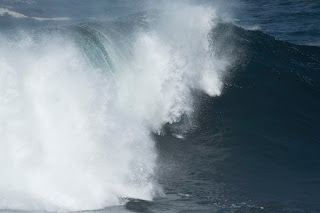The Wicks (North and South) were great for waders or maybe the American term Shorebirds works better here because the Island is full of waders but the biggest number inhabit the grasslands mainly - Curlew, the odd Whimbrel, Barwits, Lapwings, Golden Plover and zillions of Snipe. They were everywhere, on walls on roads in the morning - everywhere. We love Snipe so we were happy. Meanwhile back on the beaches it was Redshank, Sanderling and Dunlin mainly, Constantly moving with a backdrop of Seals and Eider.
The Fulmars were ever present and really close.
We visited the Holm of Papa, a small island off the east coast of Papay, it has two famous Neolithic sites, one of which was a burial chamber 70 feet long inside with side chambers for bodies. One of many amazing Orkney historical sites. One of the highlights of the whole trip occurred when a pod of 10 or so adult Risso's Dolphins appeared close in to the Holm and gave an amazing display. It was pretty memorable, we've seen Risso's well before but never so well as this.
Swallows were ever present, the last brood just fledging as we were on the Island. Twite were another breeding resident but sometimes needed a little bit of sorting out with large numbers of young Linnets knocking about.
The first Chaffinch of the autumn, there were a dozen or so around before we left.
North Wick here on a sunny day and the North-west on an equally sunny day with a swell rolling in.
There were still lots of Bonxies around, hanging about on the heather and out to sea. Just a few Arctic Skuas though, and lots of Fulmars. Three Red-breasted Mergansers joined the Eider for a day or two.
Wheatears were ever present, bouncing along everywhere every day. Maybe a hundred or so daily, many big, brightly-coloured Greenland and Iceland type birds. House Sparrows and Starlings too along the beaches and masses of the latter feeding on the kelp.
Holland Farm is like the cultural centre of the Island, amazing buildings and artifacts, all shown off, happily, by Neil Rendall the owner. It's also the best place on the Island to find a sheltering passerine migrant (along with the school). A few Pied Flycatchers, and Warblers were seen here but nothing better this timeunfortunately. We had a few near misses on our trip, a probable Buff-breasted Sandpiper disappeared before we could get closer and we missed a Juvenile Sabine's Gull, found by Julian down at the New pier by ten minutes. But such is life.
Out at the North end of the island we had some good birds. A Short-eared Owl came in-off the sea just in front of us one lunchtime and Kathy had what seems certainly to be a Rustic Bunting with the Mipits there. I missed it by seconds unfortunately. In some ways the story of the trip was Lapland Buntings. There was a bit (or a lot) of an invasion and we got more than our fair share with 50+ some days. They provided good chances for photography.
So will we be back? Yes almost certainly, next year.
It's a lovely Island, very friendly and very attractive, most people stay one or two nights but we felt two weeks was much better. It gave us a chance of some good birds (though we hit a thin period generally) and allowed us to be a part of the Island for a bit. Timing is the thing. just when is best so that it fits in with other commitments like St Agnes - which is where we are heading off to next.






































No comments:
Post a Comment